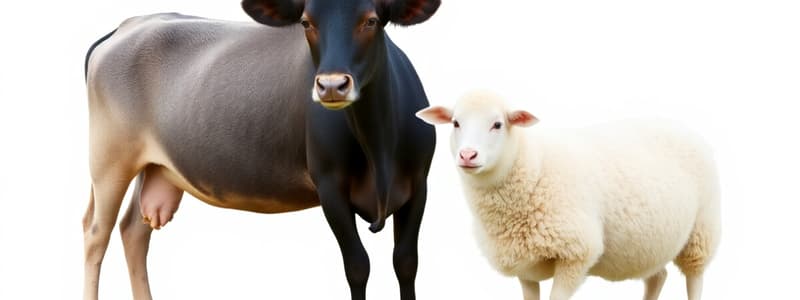Podcast
Questions and Answers
What does 'young' generally refer to in animal terms?
What does 'young' generally refer to in animal terms?
newborn or prior to puberty or sexual maturity
What is a heifer?
What is a heifer?
can be heifer calf, yearling heifer
What is 'veal'?
What is 'veal'?
meat from a calf 3 months of age or younger
Which of the following describes a bull?
Which of the following describes a bull?
What age qualifies a lamb?
What age qualifies a lamb?
What is the primary purpose of ratites?
What is the primary purpose of ratites?
A horse under 14.2 hands is referred to as a ______.
A horse under 14.2 hands is referred to as a ______.
A jack is a female ass.
A jack is a female ass.
Match the following animal with their descriptions:
Match the following animal with their descriptions:
What is the meaning of 'acclimatization'?
What is the meaning of 'acclimatization'?
What does 'cud' refer to?
What does 'cud' refer to?
Castration refers to the removal of the tail of male animals.
Castration refers to the removal of the tail of male animals.
Which animal is referred to as a jill?
Which animal is referred to as a jill?
Flashcards are hidden until you start studying
Study Notes
Animal Terminology and Definitions
- Young animals are typically newborns or pre-puberty/sexual maturity.
- Mature animals are those that have reached puberty.
- Heifers are young female cattle, sometimes categorized by age as heifer calves or yearling heifers.
- Bulls are male cattle, also categorized as bull calves or yearling bulls.
- Ewes are female sheep, sometimes categorized as ewe lambs if under one year old.
- Colts are young horses under three years of age.
- Veal is meat from calves under three months old, sometimes called bob veal.
- Lamb is meat from young sheep.
- Mutton is meat from mature sheep.
- Poultry meat is a general term for meat from birds, often named by species (e.g., turkey meat) or classified by age/weight (broiler, fryer, roaster, etc.).
Buffalo
- Domesticated horned ungulates belonging to the genus Bubalus.
- Also known as water buffalo, Asiatic buffaloes, and carabao.
Donkey
- A close relative of the horse.
- Also known as an ass or burro (Equus asinus).
- Jack (Jackass) is a male donkey.
- Jennet (Jenny) is a female donkey.
Mule
- A hybrid animal produced by breeding a male donkey (jackass) with a female horse (mare).
- Mules are reproductively sterile.
Hinny
- A hybrid animal produced by breeding a male horse (stallion) with a female donkey (jennet).
- Hinnies are reproductively sterile.
Pony
- A small type of horse, under 14.2 hands (~57 inches) in height at the withers.
Other Animal Terms
- Jill is a female mink.
- Bullock is a young bull, typically less than 20 months old.
- Jackrabbit is a wild relative of the domestic rabbit, also known as a native hare (genus Lepus).
Poultry Meat Types
- Fryer: Young meat-type chicken of either sex (typically up to 6-8 weeks old) weighing 1.3 - 2.2 kg. Also referred to as a fryer or young chicken.
- Roaster: Meat-type chicken of either sex (typically 3-5 months old) weighing about 2.95 kg average liveweight.
- Squab: Young immature pigeon, usually up to 30 days old, also refers to its meat.
- Squab Broiler: Meat-type chicken sold at 0.9-1.1 kg (2-2.5 lb) live weight. Typically smaller than a broiler, sold whole-body and never cut.
- Capon: Cockerel or a type of poultry meat from a surgically castrated male chicken, weighing 3.6 to 4.5 kg.
- Keet: Young guinea fowl.
Other Bird Types
- Ratite: Large birds including ostrich, emu, and rhea, known for their red meat and skins (for leather).
Kosher Meat
- Meat from ruminants with split hooves that have been slaughtered according to Jewish law.
Parent Terminology
- Sire: Refers to the male parent.
- Dam: Refers to the female parent.
Animal Production and Husbandry Definitions
- Acclimatization: Adaptation to an environment over time.
- Ad-libitum: As desired by the animal; self-fed.
- Aquaculture: Raising and producing fish and marine products in selected or controlled environments.
- Biosecurity: A planned system or measure to prevent the entry and spread of diseases in a flock/herd.
- Broodiness: The tendency of a hen to nest and exhibit incubating behavior.
- Brooding: Raising and caring for chicks in a protected environment (usually during the first 5-6 weeks).
- Cannibalism: The tendency or vice of animals in a herd/flock to bite/peck others, causing injuries.
- Carcass: The animal body after slaughter, excluding viscera, head, skin, and lower legs.
- Castration: The removal of the testicles of male animals.
- Comfort Zone (Thermoneutral Zone): The range of temperatures at which animal performance is maximized.
- Conformation: The structure/shape (or a cut) of an animal carcass.
- Coprophagy: The eating or consumption of feces.
- Creep Feed: Feed provided to young animals in an enclosure that excludes larger animals.
- Cud: A bolus of previously eaten food that has been regurgitated for further chewing.
- Deglutition: Swallowing.
- Eructation: A belching/burping; expulsion of accumulated gastric gases.
- Stocker: Weaned cattle fed high-roughage diets before going to the feedlot. Also used to describe light/thin feeders or mature cows purchased to utilize low-quality roughage.
- Stud: Typically refers to a breeding stallion. Also, a place where male animals are maintained.
- Stag: A male livestock mammal castrated after puberty, also refers to a young but sexually mature (~7 mos – 1 year) fighting cock.
- Lard: Fat from pigs that has been produced through a rendering process.
- Tallow: Fat from cattle, buffalo, or sheep.
- Wean: To separate a young animal from its dam and from suckling milk.
- Zebu: Tropical humped cattle breeds (Bos indicus) from the Indian subcontinent.
Studying That Suits You
Use AI to generate personalized quizzes and flashcards to suit your learning preferences.




